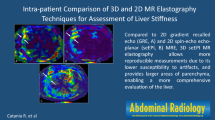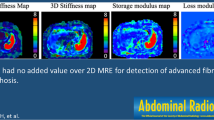Abstract
Purpose
To assess mean shear hepatic stiffness calculations using various region of interest (ROI) techniques, a new inversion algorithm, and a confidence threshold mask.
Methods
Seventy-three patients (49 with abnormal liver function tests/known chronic liver disease and 24 healthy liver transplant donors) underwent liver biopsy and magnetic resonance elastography (MRE). MRE data processed with the current inversion algorithm [multiscale direct inversion (MSDI)] was assessed using 2 ROI methods (single vs. triple). The data were then reprocessed using the new inversion algorithm (multimodel direct inversion [MMDI]) Hepatic stiffness calculations were performed using a single (70%) ROI method, with/without a 95% confidence threshold mask, and compared with MSDI.
Results
For MSDI, average stiffness difference between single and triple ROI methods was not statistically significant by the 2-sample t test [0.15 kilopascals (kPa); P = .77]. For the 2 algorithms, there was little difference in average stiffness measurements of MSDI and MMDI (mean, 0.32 kPa; 9%) using a confidence mask with good agreement [intraclass correlation coefficient (ICC), 0.986 (95% CI 0.975–0.994)]. Use of the confidence mask showed excellent consistency and less variance [ICC, 0.995 (95% CI 0.993–0.998)] compared to either the inter-observer or intra-observer freehand technique.
Conclusion
MRE analysis showed no significant difference between the 2 freehand ROI techniques. With a 9% average kPa variance, stiffness measurements for MSDI and MMDI were also not significantly different. The use of the confidence mask reduces calculated stiffness variability, which impacts the use of MRE for assessing therapy response and initial/longitudinal assessment of chronic liver disease.







Similar content being viewed by others
Explore related subjects
Discover the latest articles, news and stories from top researchers in related subjects.Abbreviations
- ICC:
-
Intraclass correlation coefficient
- kPA:
-
Kilopascals
- MMDI:
-
Multimodel direct inversion
- MRE:
-
Magnetic resonance elastography
- MSDI:
-
Multiscale direct inversion
- ROI:
-
Region of interest
References
Jepsen P, Vilstrup H, Andersen PK, Lash TL, Sorensen HT (2008) Comorbidity and survival of Danish cirrhosis patients: a nationwide population-based cohort study. Hepatology 48(1):214–220
Wan Y, Tang MH, Chen XC, et al. (2014) Inhibitory effect of liposomal quercetin on acute hepatitis and hepatic fibrosis induced by concanavalin A. Braz J Med Biol Res 47(8):655–661
Li J, Li X, Xu W, et al. (2014) Antifibrotic effects of luteolin on hepatic stellate cells and liver fibrosis by targeting AKT/mTOR/p70S6K and TGFβ/Smad signalling pathways. Liver Int. doi:10.1111/liv.12638
Jobara K, Kaido T, Hori T, et al. (2014) Whey-hydrolyzed peptide-enriched immunomodulating diet prevents progression of liver cirrhosis in rats. Nutrition 30(10):1195–1207
Giannitrapani L, Soresi M, Bondi ML, Montalto G, Cervello M (2014) Nanotechnology applications for the therapy of liver fibrosis. World J Gastroenterol 20(23):7242–7251
Rey JW, Jahn-Eimermacher A, Doernberger V, et al. (2014) To biopsy or not to biopsy: evaluation of a large German cohort of patients with abnormal liver tests of unknown etiology. Digestion 89(4):310–318
Nalbantoglu I, Brunt EM (2014) Role of liver biopsy in nonalcoholic fatty liver disease. World J Gastroenterol 20(27):9026–9037
Perrault J, McGill DB, Ott BJ, Taylor WF (1978) Liver biopsy: complications in 1000 inpatients and outpatients. Gastroenterology 74(1):103–106
Thampanitchawong P, Piratvisuth T (1999) Liver biopsy: complications and risk factors. World J Gastroenterol 5(4):301–304
Guo Y, Parthasarathy S, Goyal P, et al. (2014) Magnetic resonance elastography and acoustic radiation force impulse for staging hepatic fibrosis: a meta-analysis. Abdom Imaging. doi:10.1007/s00261-014-0137-6
Venkatesh SK, Ehman RL (2014) Magnetic resonance elastography of liver. Magn Reson Imaging Clin N Am 22(3):433–446
Friedman SL, Rockey DC, Bissell DM (2007) Hepatic fibrosis 2006: report of the Third AASLD Single Topic Conference. Hepatology 45(1):242–249
Yeh WC, Li PC, Jeng YM, et al. (2002) Elastic modulus measurements of human liver and correlation with pathology. Ultrasound Med Biol 28(4):467–474
Muthupillai R, Lomas DJ, Rossman PJ, et al. (1995) Magnetic resonance elastography by direct visualization of propagating acoustic strain waves. Science 269(5232):1854–1857
Rouviere O, Yin M, Dresner MA, et al. (2006) MR elastography of the liver: preliminary results. Radiology 240(2):440–448
Huwart L, Peeters F, Sinkus R, et al. (2006) Liver fibrosis: non-invasive assessment with MR elastography. NMR Biomed 19(2):173–179
Yin M, Talwalkar JA, Glaser KJ, et al. (2007) Assessment of hepatic fibrosis with magnetic resonance elastography. Clin Gastroenterol Hepatol 5(10):1207–1213
Mitsufuji T, Shinagawa Y, Fujimitsu R, et al. (2013) Measurement consistency of MR elastography at 3.0 T: comparison among three different region-of-interest placement methods. Jpn J Radiol 31(5):336–341
Lee DH, Lee JM, Han JK, Choi BI (2013) MR elastography of healthy liver parenchyma: normal value and reliability of the liver stiffness value measurement. J Magn Reson Imaging 38(5):1215–1223
Dzyubak B, Glaser K, Yin M, et al. (2013) Automated liver stiffness measurements with magnetic resonance elastography. J Magn Reson Imaging 38(2):371–379
Goodman ZD (2007) Grading and staging systems for inflammation and fibrosis in chronic liver diseases. J Hepatol 47(4):598–607
Venkatesh SK, Wang G, Lim SG, Wee A (2014) Magnetic resonance elastography for the detection and staging of liver fibrosis in chronic hepatitis B. Eur Radiol 24(1):70–78
Bohte AE, Garteiser P, De Niet A, et al. (2013) MR elastography of the liver: defining thresholds for detecting viscoelastic changes. Radiology 269(3):768–776
Runge JH, Bohte AE, Verheij J, et al. (2014) Comparison of interobserver agreement of magnetic resonance elastography with histopathological staging of liver fibrosis. Abdom Imaging 39(2):283–290
Kim D, Kim WR, Talwalkar JA, Kim HJ, Ehman RL (2013) Advanced fibrosis in nonalcoholic fatty liver disease: noninvasive assessment with MR elastography. Radiology 268(2):411–419
Chen J, Talwalkar JA, Yin M, et al. (2011) Early detection of nonalcoholic steatohepatitis in patients with nonalcoholic fatty liver disease by using MR elastography. Radiology 259(3):749–756
Salameh N, Larrat B, Abarca-Quinones J, et al. (2009) Early detection of steatohepatitis in fatty rat liver by using MR elastography. Radiology 253(1):90–97
Hines CD, Bley TA, Lindstrom MJ, Reeder SB (2010) Repeatability of magnetic resonance elastography for quantification of hepatic stiffness. J Magn Reson Imaging 31(3):725–731
Mannelli L, Godfrey E, Graves MJ, et al. (2012) Magnetic resonance elastography: feasibility of liver stiffness measurements in healthy volunteers at 3T. Clin Radiol 67(3):258–262
Conflict of interest
Richard L. Ehman holds patents and has a financial interest through royalties related to MRE technology.
Author information
Authors and Affiliations
Corresponding author
Rights and permissions
About this article
Cite this article
Silva, A.M., Grimm, R.C., Glaser, K.J. et al. Magnetic resonance elastography: evaluation of new inversion algorithm and quantitative analysis method. Abdom Imaging 40, 810–817 (2015). https://doi.org/10.1007/s00261-015-0372-5
Published:
Issue Date:
DOI: https://doi.org/10.1007/s00261-015-0372-5




